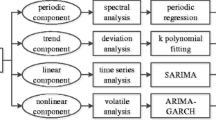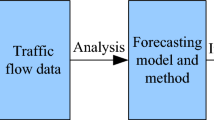Abstract
Short-term traffic flow forecasting is a key step to achieve the performance of intelligent transportation system (ITS). Timely and accurate traffic information prediction is also the prerequisite of realizing proactive traffic control and dynamic traffic assignment effectively. Based on the fact that univariate forecasting methods have limited forecasting abilities when the data is missing or erroneous and that single models make no full use of information underline data, a new hybrid method with multivariate for short-term traffic flow forecasting is proposed. This method combines statistical analysis method with computational intelligence techniques to mine the characteristic of traffic flow as well as forecast short-term traffic state. First, the wavelet de-noising is employed to remove the noise information. Then, time series analysis is used to analyze time-varying and periodic characteristic of traffic flow. Furthermore, the seasonal auto-regressive moving average with external input (SARIMAX) is established to fit traffic flow with occupancy as exogenous variables. Finally, wavelet forecast is adopted to forecast the values of occupancy which are used as exogenous input, and a WSARIMAX is constructed to forecast traffic flow. Using the relationship of flow and occupancy at the same road section and taking traffic flow and occupancy data from freeway I-694 EB in the Twin Cities as endogenous variables and exogenous variables respectively, this paper studies the forecasting performance of the proposed method. The study results are encouraging. Compared with SARIMA newly proposed in literature, WSARIMA and SARIMAX improved method with wavelet analysis and multivariate modeling method, the proposed method gets improvements of 12.95%, 12.62% and 10.41% in forecasting accuracy of one-step ahead respectively. For ten-steps ahead forecasting, it gets improvements of 18.87%, 17.05% and 2.57% in forecasting accuracy respectively.







Similar content being viewed by others
References
Wang Y, Geroliminis N, Leclercq L (2016) Recent advances in ITS, traffic flow theory, and network operations. Transp Res C: Emerg Technol 68:507–508
Rota BCR, Simic M (2016) Traffic flow optimization on freeways. Procedia Comput Sci 96:1637–1646
Zhang Y, Zhang Y (2016) A comparative study of three multivariate Short-Term freeway traffic flow forecasting methods with missing data. J Intell Transp Syst 20(3):205–218
Ghosh B, Basu B (2009) Multivariate Short-Term Traffic Flow Forecasting Using Time-Series Analysis. IEEE Trans Intell Transp Syst 10(2):246–254
Dong C, Shao Z, Xiong C, Zhang H (2015) A spatial-temporal-based state space approach for freeway network traffic flow modelling and prediction. Transportmetrica: A Transport Science 11(6):1–14
Pang X, Wang C, Huang G (2016) A short-term traffic flow forecasting method based on a three-layer k-nearest neighbor non-parametric regression algorithm. J Transp Technol 6:200–206
Cheng A, Jiang X, Li Y et al. (2016) Multiple sources and multiple measures based traffic flow prediction using the chaos theory and support vector regression method. Physica A Statistical Mechanics &, Its Applications 466:422–434
Cong Y, Wang J, Li X (2016) Traffic flow forecasting by a least squares support vector machine with a fruit fly optimization algorithm. Procedia Eng 137:59–68
Tang J, Liu F, Zou Y, Zhang W, Wang Y (2017) An improved fuzzy neural network for traffic speed prediction considering periodic characteristic. IEEE Transactions on Intelligent Transportation Systems, 99:1:11
Moretti F, Pizzuti S, Panzieri S, Annunziato M (2015) Urban traffic flow forecasting through statistical and neural network bagging ensemble hybrid modeling. Neurocomputing 167(C):3–7
Hu W, Yan L, Liu K, Wand H (2016) A short-term traffic flow forecasting method based on the hybrid PSO-SVR. Neural Process Lett 43:155–172
Wang C, Ye Z (2015) Traffic flow forecasting based on a hybrid model. J Intell Transp Syst 20(5):428–437
Liu S, Hellendoorn H, Schutter B D (2017) Model predictive control for freeway networks based on Multi-Class traffic flow and emission models. IEEE Trans Intell Transp Syst 18(2):306–320
Liu S, Chen W, Chi Q, Yan H (2017) Day-to-day dynamical evolution of network traffic flow with elastic demand. Acta Phys Sin 66(6):8–22
Ni D (2016) Traffic Flow Theory. In: Ni D (ed) Chapter 24 multiscale traffic flow modeling. Butterworth-Heinemann, Oxford, pp 361–377
Wang J, Shi Q (2013) Short-term traffic speed forecasting hybrid model based on chaos–wavelet analysis-support vector machine theory. Transportation Research Part C: Emerging Technologies 27:219–232
Lopez-Garcia P, Onieva E, Osaba E, Masegosa A (2016) A hybrid method for short-term traffic congestion forecasting using genetic algorithms and cross entropy. IEEE Trans Intell Transp Syst 17(2):557–569
Moretti F, Pizzuti S, Annunziato M, Annunziato M (2015) Urban traffic flow forecasting through statistical and neural network bagging ensemble hybrid modeling. Neurocomputing 167(C):3–7
Chen H, Grant-Muller S, Mussone L, F Montgomery F (2001) A study of hybrid neural network approaches and the effects of missing data on traffic forecasting. Neural Computing &, Applications 10(3):277–286
Corrêa J, Neto A, Júnior L et al. (2016) Time series forecasting with the WARIMAX-GARCH method. Neurocomputing 216:805–815
Paul R (2015) ARIMAX-GARCH-WAVELET model for forecasting volatile data. Model Assist Stat Appl & Appl 10(3):243–252
Zhang Y, Zhang Y (2016) A comparative study of three multivariate short-term freeway traffic flow forecasting methods with missing data. J Intell Transp Syst 20(3):205–218
Yin Y, Shang P (2016) Forecasting traffic time series with multivariate predicting method. Appl Math Comput 291:266–278
Ghosh H, Paul R, Prajneshu (2010) Wavelet frequency domain approach for statistical modeling of rainfall time-series data. Journal of Statistical Theory and Practice 4(4):813–825
Wenigera M, Kappa F, Friederichsa P (2017) Spatial verification using wavelet transforms: a review. Q J R Meteorol Soc 143(702):120–136
Lu J, Lin H, Ye D, Zhang Y (2016) A new wavelet threshold function and denoising application. Math Probl Eng 2016(3):1–8
Aminghafari M, Poggi J (2012) Nonstationary time series forecasting using wavelets and kernel smoothing. Communication in Statistics - Theory Methods 41(3):485–499
Kumar S, Vanajakshi L (2015) Short-term traffic flow prediction using seasonal ARIMA model with limited input data. European Transport Research Review 7(3):21
Brett l (2015) Machine learning with R - Second Edition. PACKT Publishing, Birmingham
Acknowledgments
The authors are grateful to the anonymous reviewers for their comments, which will help to improve our paper.
Funding
This work was supported by National Natural Science Foundation of China [Grant No.61663021]; Scientific Research Project in Universities of Gansu [Grant No. 2015B-031]; Science and Technology Support Program of Gansu [Grant No.1304GKCA023].
Author information
Authors and Affiliations
Corresponding author
Rights and permissions
About this article
Cite this article
Zhang, H., Wang, X., Cao, J. et al. A multivariate short-term traffic flow forecasting method based on wavelet analysis and seasonal time series. Appl Intell 48, 3827–3838 (2018). https://doi.org/10.1007/s10489-018-1181-7
Published:
Issue Date:
DOI: https://doi.org/10.1007/s10489-018-1181-7




